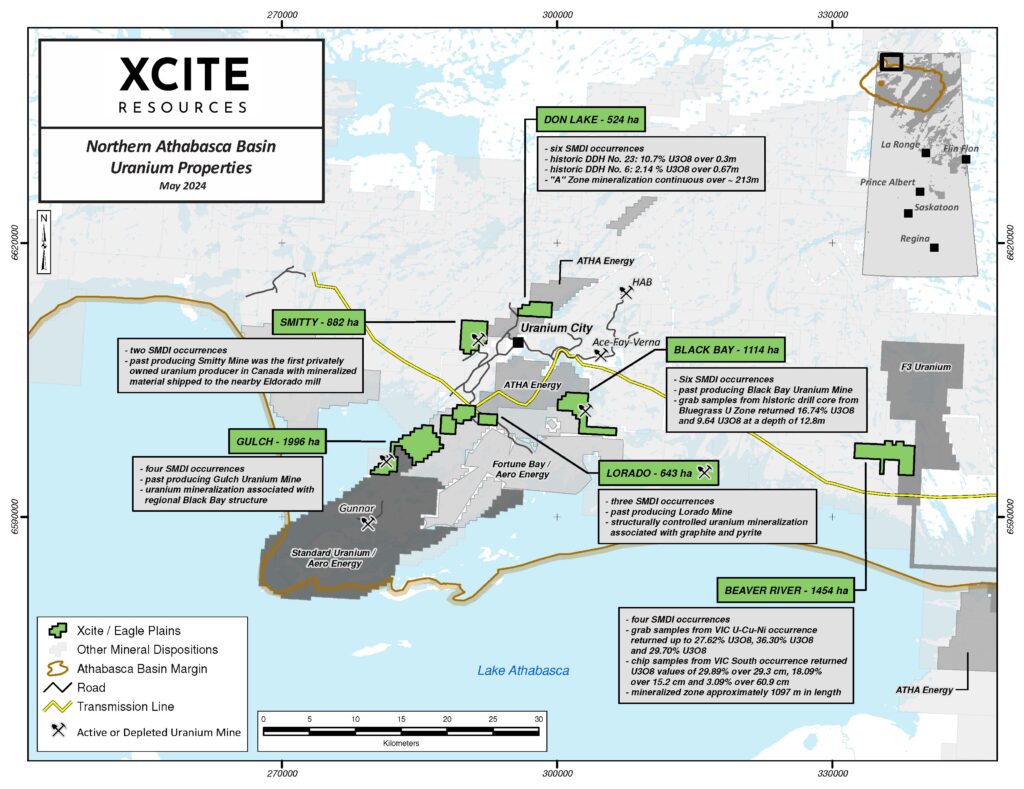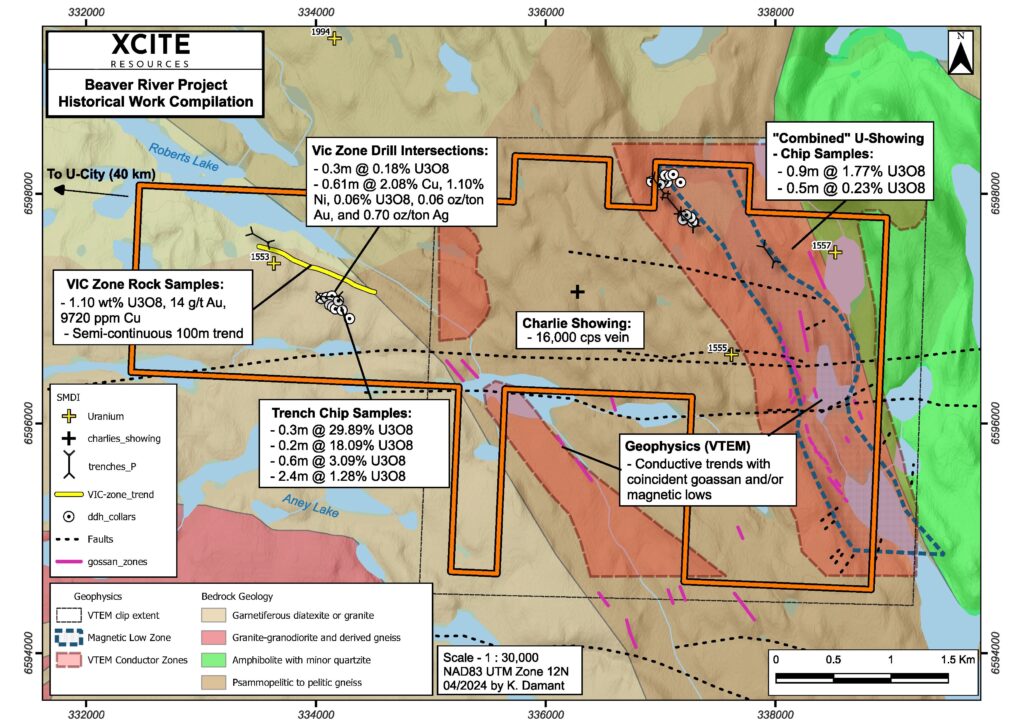Vancouver, British Columbia, May 2nd, 2024: Xcite Resources Inc. (CSE:XRI) (“XRI or Xcite”), has
received the results from a data compilation on the Beaver River uranium project, located 40km SE of
Uranium City, Saskatchewan. The Beaver River project hosts near-surface high-grade uranium
mineralization. The compilation and interpretation of available data will lead to recommendations for 2024
fieldwork.

Beaver River Data Compilation Highlights
- Historical assays up to 29.89% U3O8 in trench chip samples.
- Historical drill intersections include 0.18% U3O8 over 0.3m and 0.06% U3O8 over 0.61m.
- Recognized mineralized trend >1km in length.
- Prospective for polymetallic Beaverlodge-type uranium mineralization in E-W and NW-SE
trending fault zones.

About the Beaver River Project
The 1455ha project overlies 5 Saskatchewan Mineral Deposit Index (“SMDI”) occurrences associated
with Beaverlodge-type uranium mineralization.
The polymetallic VIC U-Cu-Ni zone (SMDI 1551, 1553, and 1994) occurs along a NW-SE trending fault
zone which has been traced for approximately 1 km. Mineralization occurs in fracture filling of quartz
veins hosting sulphides, graphite, and pitchblende and uraninite, ore minerals of uranium. Historical assays
of channel samples in this zone yield up to 29.89% U3O8 over 0.3m, 18.09% U3O8 over 0.2m and 3.09%
U3O8 over 0.6m (AF 74O05-0077). The southeast zone has been tested by nine shallow drill holes,
averaging 80m in length, returning assays of 0.18% U3O8 over 0.3m (AF74O05-0016) and 0.06% U3O8
over 0.61m along with anomalous copper, nickel, gold and silver (AF74O05-0051). The northwest portion
of the VIC zone, identified as a priority for follow-up by Denison Mines, has yet to be tested by drilling.
Another significant mineral occurrence on the Beaver River property is the Combined Mining Uranium
Showing (SMDI 1557) where northeast-trending pitchblende-bearing fractures have ben mapped over a
strike length of 137.2m. Assays from trenches yielded 0.23% U3O8 over 0.5m and 1.77% U3O8 over
0.9m.
Since uranium mineralization on the Beaver River property was first noted in 1958 the property has seen
a total of 1708m of diamond drilling in 26 shallow holes, with the last drilling completed in 1969 by Trans-
Canada Resources. Other historical work includes prospecting, mapping, scintillometer surveys, trenching
at the main showing areas, and airborne and ground-based geophysics.
An electromagnetic and magnetic VTEM survey flown by Geotech for Fission 3.0 in 2016 covered the
eastern part of the Beaver River property. The survey outlined numerous areas of enhanced conductivity
including areas of parallel conductors with offsets and termination points indicative of cross structure,
including a high priority conductive trend located west of the Combined SMDI occurrence. Follow-up
prospecting and geochemical sampling was recommended to evaluate the source of the anomalies.
The last recorded assessment work on the project was by Fission 3.0 who successfully located and
resampled historic trenches at the VIC occurrence.
Management of Eagle Plains and Xcite are encouraged by the tenor of mineralization displayed in trenches
and shallow historical drilling at Beaver River and the potential for additional uranium mineralization both
along strike and to depth within known mineralized areas and on any additional targets generated by 2024
work.
Rock grab samples are selective samples by nature and as such are not necessarily representative of the
mineralization hosted across the property. The above results were taken directly from the SMDI
descriptions and assessment reports) filed with the Saskatchewan government. Management cautions that
historical results were collected and reported by past operators and have not been verified nor confirmed
by a Qualified Person, but form a basis for ongoing work on the subject properties. Management cautions
that past results or discoveries on proximate land are not necessarily indicative of the results that may be
achieved on the subject properties.
XCITE ANNOUNCE CHANGE TO THEIR BOARD OF DIRECTORS
Xcite has appointed Tracy Weslosky as director of the company effective May 3rd, 2024, and Daryn
Gordon resigned as director. The company wishes to thank Mr. Gordon for their contributions to the board,
he will remain with the company as CFO.
Tracy Weslosky
Executive Director, Critical Minerals Institute (CMI)
CEO, Publisher & Director, InvestorNews Inc.
Tracy Weslosky is the CEO, Publisher and Director of InvestorNews Inc., a company that has been a
leader in digital media services within the capital markets for over two decades. She is also the Executive
Director of the Critical Minerals Institute (CMI), a global organization that enhances collaboration and
expertise in the critical minerals market, offering resources, government contract access, and networking
opportunities for businesses and professionals.
In her earlier career, Tracy co-founded REE Stocks PLC, a rare earths indices company recognized by
FTSE, and served as a principal partner in the boutique investment banking firm Weslosky & Cowans
Ltd., which maintained an Exempt Market Dealers license for eight years. She also hosted and produced
the business television series “DealFlow,” reaching 294 million households worldwide, including
broadcasts on CNBC.
Tracy holds a BA in Political Science from the University of Tennessee, obtained in 1988. A noted speaker,
host, and columnist, she maintains several directorships in the capital markets and is recognized as an
influential writer in the field.
Xcite Resources Inc. has granted 100,000 stock options to Tracy Weslosky, each option is exercisable for
one common share of the company at a price of $0.20 cents for 5 years.
About the Beaverlodge Uranium District
The Beaver River, Black Bay, Don Lake, Gulch, Larado, and Smitty projects are located in the
Beaverlodge District near Uranium City in the Lake Athabasca region of Saskatchewan. Occurrences of
uranium mineralization are abundant in the Uranium City area and have been explored and documented
since the 1940s. The Beaverlodge camp was the first uranium producer in Canada, with historic production
of approximately 70.25 million pounds of U3O8 between 1950-1982, from ore grades averaging 0.23%
U3O8. The two largest producers were the Eldorado Beaverlodge (Ace-Fay-Verna) mine and the Gunnar
uranium mine. The Beaverlodge area has seen limited uranium focused exploration since the early 1990’s.
Eagle Plains’ management cautions that past results or discoveries on proximate land are not necessarily
indicative of the results that may be achieved on the subject properties.
Beaverlodge-style uranium deposits host structurally controlled, high grade mineralization in veins and
breccia-fills within basement rocks. Mineralization often occurs at geological contacts and consists of
structures filled with hematite, chlorite and graphite associated with pitchblende.
Qualified Person
Technical information in this News Release has been reviewed and approved by C.C. Downie, P.Geo., a
director and officer of Eagle Plains, hereby identified as the “Qualified Person” under N.I. 43-101.
About Xcite Resources Inc.
Xcite Resources is an early-stage exploration company working to become a leader in the discovery and
development of energy transition metals. The uranium project portfolio in the Athabasca Basin will propel
our efforts to achieve a high-grade discovery.
